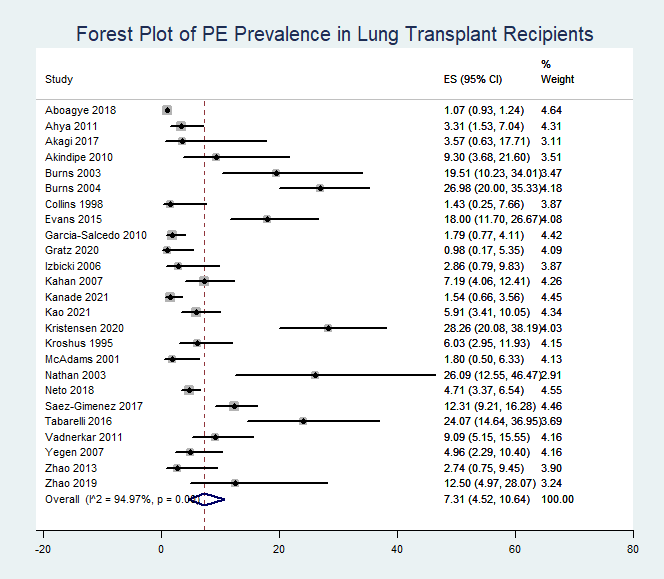Pooled Prevalence of Pulmonary Embolism in Lung Transplant Recipients – A Meta-Analysis
F. Pyarali, A. Stevens, R. Rampolla
Department of Pulmonary and Critical Care, Cedars Sinai Medical Center, Los Angeles, CA
Meeting: 2022 American Transplant Congress
Abstract number: 1495
Keywords: Lung, Lung transplantation, Meta-analysis
Topic: Clinical Science » Lung » 64 - Lung: All Topics
Session Information
Session Time: 7:00pm-8:00pm
 Presentation Time: 7:00pm-8:00pm
Presentation Time: 7:00pm-8:00pm
Location: Hynes Halls C & D
*Purpose: Similar to other operations, lung transplantation surgery has been associated with an increased risk of venous thromboembolism. While various studies have aimed to estimate the prevalence of pulmonary embolism (PE) in their populations, a meta-analysis estimating pooled prevalence has not been performed. The aim of this study was to combine the available literature to evaluate a pooled prevalence of pulmonary embolism among lung transplant recipients.
*Methods: Three databases were searched for this study – PubMed, EmBase, and Web of Science. Search keywords included “lung transplant” or “lung transplantation”, and “pulmonary embolism” or “venous thromboembolism.” Search was limited to published peer-reviewed articles. Articles were excluded if they did not stratify patients with pulmonary embolism. Two investigators reviewed the resulting abstracts and selected abstracts for full-text review. Studies were analyzed using random effects models, and pooled prevalence was estimated after Freeman-Tukey transformation.
*Results: A total of 417 articles were reviewed on initial search, and 37 unique articles were selected for full review. 26 articles were included in the final analysis, including 20,051 patients. Transplants took place between 1986 and 2018. Most studies were performed in the United States (64.0%). In most articles (68.4%) females were the minority of the patient population. Bilateral transplants were most common in the majority (60.0%) of reviewed articles. Most articles used ventilation/perfusion (VQ) scan or computed tomography angiography (CTA) for the diagnosis of pulmonary embolism (80%), while others used pathology (15%) or administrative data (5%). The pooled prevalence of pulmonary embolism was 7.31%. Prevalence was similar when comparing studies taking place in the USA and outside the USA (6.98% US vs. 7.85% outside of US). The pooled prevalence was lower among studies taking place after 2000 vs. before 2000 (4.74% post-2000 vs. 10.2% pre-2000), suggesting that the prevalence could be decreasing over time. When looking at studies that looked at pathologic or administrative diagnosis of pulmonary embolism, the pooled prevalence was higher compared to the typical diagnosis with CT or VQ scan (11.8% vs. 6.64%).
*Conclusions: The prevalence of pulmonary embolism in lung transplant recipients varies widely, with a pooled prevalence of approximately 7%, with possible evidence of decreasing prevalence over time. Clinicians should have a high index of suspicion of pulmonary embolism when treating patients with lung transplant presenting with hypoxemia.
To cite this abstract in AMA style:
Pyarali F, Stevens A, Rampolla R. Pooled Prevalence of Pulmonary Embolism in Lung Transplant Recipients – A Meta-Analysis [abstract]. Am J Transplant. 2022; 22 (suppl 3). https://atcmeetingabstracts.com/abstract/pooled-prevalence-of-pulmonary-embolism-in-lung-transplant-recipients-a-meta-analysis/. Accessed December 12, 2025.« Back to 2022 American Transplant Congress

